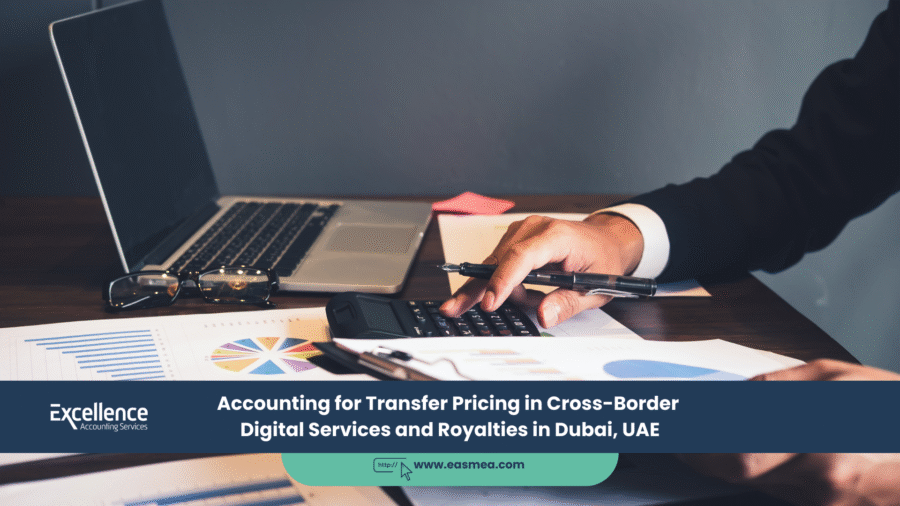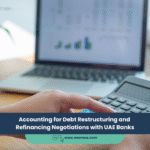Accounting for Transfer Pricing in Cross-Border Digital Services and Royalties
The digital economy has erased borders, allowing businesses to deliver services and license intellectual property across the globe with unprecedented ease. For multinational enterprises operating in the UAE, this creates immense opportunities. However, it also places them at the center of the most complex area in international tax: transfer pricing for digital services and royalties.
- Accounting for Transfer Pricing in Cross-Border Digital Services and Royalties
- The Borderless Challenge: Defining Digital Services and Royalties
- Applying the Arm's Length Principle to Intangibles
- What Excellence Accounting Services (EAS) Can Offer
- Frequently Asked Questions (FAQs)
- Value Your Innovation. Defend Your Price.
When a UAE-based subsidiary pays its foreign parent company for access to a software platform, a brand name, or centralized IT support, this is a cross-border related-party transaction. The price set for this transaction—the transfer price—directly impacts how much profit is reported (and taxed) in each country. With the introduction of UAE Corporate Tax and the global implementation of the OECD’s BEPS 2.0 framework, tax authorities are scrutinizing these transactions like never before.
This guide provides a crucial overview for finance leaders on the accounting and tax principles for pricing cross-border digital services and royalty payments. We will explore the challenges of valuing intangible assets, applying the arm’s length principle, and maintaining the documentation required to defend your transfer pricing policies.
Key Takeaways
- Intangibles are the Focus: Transfer pricing for digital services is all about the valuation of the underlying intellectual property (IP) and intangible assets.
- The Arm’s Length Principle is Mandatory: All related-party transactions must be priced as if they were between two independent, unrelated companies.
- Value Creation Drives Profit Allocation: Under modern tax principles, profit should be allocated to the countries where the economic activities that create value (like R&D or marketing) actually occur.
- Documentation is Not Optional: UAE law requires businesses to prepare and maintain specific transfer pricing documentation (Master File, Local File) to justify their pricing.
- Digital PE Risk is Real: Significant and sustained digital activity in the UAE could create a “Digital Permanent Establishment,” triggering unforeseen tax liabilities.
The Borderless Challenge: Defining Digital Services and Royalties
Transfer pricing rules apply to a wide range of cross-border transactions that are common in modern business structures:
- Royalty Payments: A UAE subsidiary pays a royalty to its foreign parent for the right to use a brand name, patented technology, or proprietary software in its products.
- Software as a Service (SaaS): A UAE entity pays a recurring fee to a related foreign entity for access to a cloud-based software platform used for its operations.
- Intra-Group Services: A UAE company pays a management fee to its parent company for centralized services like IT support, HR, finance, and strategic management.
- Digital Marketing Services: A local entity pays a related overseas marketing hub for global digital advertising campaigns and brand management.
In each case, the core accounting challenge is the same: how to determine a fair, compliant, and defensible price for these transactions. Our introduction to transfer pricing provides more background.
Applying the Arm’s Length Principle to Intangibles
The cornerstone of transfer pricing is the arm’s length principle. For tangible goods, this can be straightforward. For digital services and intangibles, it’s far more complex. The OECD Transfer Pricing Guidelines provide several methods, but for digital transactions, the most common are:
| Method | How It Works | When It’s Used |
|---|---|---|
| Comparable Uncontrolled Price (CUP) | Finding the price charged for the same or a very similar service or royalty between two unrelated parties. | The preferred method, but often difficult to apply because truly comparable independent transactions for unique IP are rare. |
| Transactional Net Margin Method (TNMM) | Examines the net profit margin a company makes from a controlled transaction and compares it to the margins made by independent companies in similar transactions. | A very common method used for routine services like IT support or administrative services. |
| Profit Split Method | Splits the total profits from a transaction between the related parties based on their relative contributions and value creation. | Used for highly integrated transactions where both parties contribute unique and valuable intangibles (e.g., joint development of software). |
Choosing and applying the correct method requires deep analysis and often the support of business valuation experts.
In the digital age, a company’s most valuable assets are often lines of code and brand reputation. Transfer pricing is the discipline of assigning a fair value to these assets as they cross digital borders.
What Excellence Accounting Services (EAS) Can Offer
Navigating the complexities of digital transfer pricing requires specialized expertise at the intersection of accounting, tax law, and economics. Excellence Accounting Services provides comprehensive support to ensure your cross-border transactions are compliant and efficient.
- Transfer Pricing Policy Design: We help you design and implement a robust transfer pricing framework for your digital services and royalty payments, selecting the most appropriate methods.
- Documentation Preparation: Our team prepares the Master File, Local File, and any other documentation required to comply with the Federal Tax Authority (FTA) regulations and defend your position under audit.
- Valuation of Intangibles: We work with valuation experts to determine the arm’s length value of your intellectual property, software licenses, and intra-group services.
- BEPS 2.0 and Digital PE Advisory: We provide strategic business consultancy to help you understand and navigate the implications of global tax changes on your digital business model.
- Tax Audit & Dispute Resolution: If your transfer pricing policies are challenged, we provide the expert support needed to manage the audit and resolve disputes with tax authorities.
Frequently Asked Questions (FAQs)
BEPS 2.0 is a global tax reform initiative led by the OECD. Its “Pillar One” aims to reallocate a portion of the profits of the largest multinational enterprises to the market jurisdictions where their users and customers are located, even if they have no physical presence there. This fundamentally changes how digital companies are taxed globally.
Yes, absolutely. A general “management fee” is a major red flag for tax auditors. You must be able to break down that fee, show exactly what services were provided, and justify that the price charged is at arm’s length. Without documentation, the deduction could be denied.
You must analyze the DEMPE functions—Development, Enhancement, Maintenance, Protection, and Exploitation of the intangible asset. The entity that performs and funds these key functions is the one that has created the value and is entitled to the majority of the return (the royalty).
Historically, a simple website was not considered a PE. However, under modern interpretations related to the digital economy, a highly interactive website that facilitates the conclusion of contracts could, in some circumstances, be argued to create a PE. The risk is higher if it’s combined with local employees supporting the digital sales function.
This is a tax that some countries require the payer of a royalty to “withhold” from the payment and remit directly to the tax authority. The UAE currently has a 0% withholding tax on domestic and cross-border payments, but this is an important factor when dealing with other countries.
This would likely be analyzed using the TNMM. The distributor (the UAE entity) would be entitled to a routine profit margin for its distribution functions. The vast majority of the residual profit would be allocated to the parent company that developed, owns, and maintains the valuable software IP.
The Local File provides detailed information about the local entity’s specific related-party transactions. The Master File provides a high-level global overview of the multinational group’s business, value chains, and overall transfer pricing policies.
Yes. While the full Master File/Local File documentation requirements in the UAE have revenue thresholds, the underlying requirement to conduct all related-party transactions at arm’s length applies to all businesses subject to UAE Corporate Tax.
The tax authority can make an adjustment to your taxable income, effectively re-pricing the transaction to what it deems is the correct arm’s length price. This results in a higher tax liability, plus significant financial penalties for non-compliance.
You should review them annually. Business operations change, profit margins fluctuate, and the functions performed by different entities can evolve. An annual review ensures your policies and documentation remain consistent with the economic reality of your business.
Conclusion: Navigating the New Digital Tax Landscape
Transfer pricing for digital services and royalties is no longer a niche compliance issue; it is a central pillar of international tax strategy. For businesses in the UAE, understanding these rules is essential for managing risk and ensuring sustainable growth.
By proactively structuring transactions, meticulously valuing intangibles, and maintaining robust documentation, companies can navigate the complexities of the digital economy with confidence and build a tax strategy that is as innovative as their services.
Value Your Innovation. Defend Your Price.
Let Excellence Accounting Services help you develop and document a transfer pricing strategy that stands up to scrutiny.




